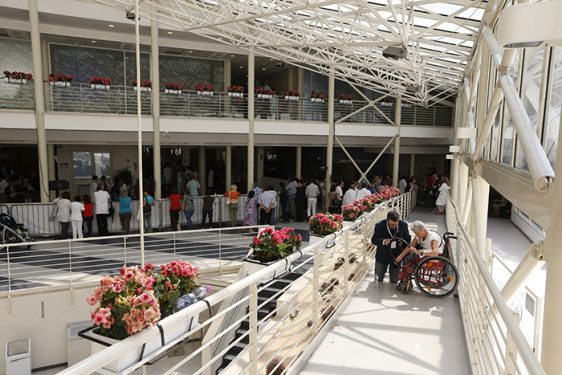
By Elise Ann Allen
ROME (Crux) — Pope Francis is currently recovering from colon surgery at Rome’s Gemelli hospital, also known as “the pope’s hospital” or “the third Vatican” given some of its more high-profile patients over the years.
On Sunday, July 4, shortly after the pontiff presided over his noontime Angelus address, the Vatican announced that Pope Francis, 84, had gone to Gemelli for a scheduled surgery for stenotic diverticulitis, meaning a restriction and inflammation of the colon.
[Related: Pope Francis Out of Bed, Walking After Surgery at Rome Hospital]
Pope Francis “is in good condition, he’s alert, and is breathing on his own,” the Vatican said Sunday evening, saying the Holy Father will likely stay in the hospital for about seven days to recover, pending any complications.
Pope Francis has had a few minor bouts of illness and sciatica throughout his eight-year pontificate, but this marks the first time he has been admitted to the hospital since his election in March 2013.
While the surgery itself came as a surprise to many, since the Vatican had not announced it beforehand, there was no question as to where the procedure would take place.
Ever since the assassination attempt against Pope St. John Paul II in May 1981, Gemelli has become the go-to health facility for popes.
Pope John Paul II himself, after being rushed to Gemelli following the failed attempt on his life by Mehmet Ali Ağca, was admitted to Gemelli roughly 10 other times in the course of his 25-year pontificate, including once in 1992 for the removal of a benign tumor in his colon.
In fact, Pope John Paul’s preference for Gemelli contributed to the bequeathment of its unofficial title as “the third Vatican,” the first being Vatican City itself, and the second being the papal summer residence of Castel Gandolfo, which Pope Francis doesn’t use.
Established in 1959 and officially opening its doors in 1964, Gemelli is one of the largest private hospitals in Europe. It is named after Italian Franciscan friar, physician, and psychologist Agostino Gemelli, and is owned by the Catholic University of the Sacred Heart, which was founded in 1921 in Milan and is the largest privately owned university in Italy.
Containing 1,575 beds, the hospital carries out both basic and clinical research, and provides on-site housing for medical students.
Four other buildings belonging to the Gemelli structure include the Biological Institutes, the Protected Health Residence, the combined Institute of Infectious Diseases, and Centre for the Medicine of Aging.
Pope Francis’ own personal doctor, Roberto Bernabei — named as papal physician in February — is a professor of internal medicine at the Catholic University of the Sacred Heart, and is director of the Department of Aging, Orthopedics, and Rehabilitative Medicine at Gemelli.
Other famous former patients of the hospital include Nobel Laureate Mother Teresa, high-profile theoretical physicist Stephen Hawking, soccer stars Francesco Totti and Daniele De Rossi, and Georg Ratzinger, the late brother of retired Pope Benedict XVI.
Pope Benedict XVI himself was never admitted to Gemelli during his eight years as pope, but he visited on several occasions, including two personal visits to his brother Georg, who was admitted and fitted with a pacemaker in 2005, and again for health troubles after Christmas in 2013.
In 2009, Pope Benedict went to Gemelli to visit French Cardinal Roger Etchegaray, who was admitted after falling and breaking his leg and hip when a mentally unstable woman attacked Pope Benedict on Christmas Eve, pushing him and Cardinal Etchegaray to the ground.
(Etchegaray broke his leg again in 2015, while greeting Pope Francis at the close of a morning Mass in St. Peter’s Square. The pope later paid him a personal visit for this injury, too. Cardinal Etchegaray died in 2019 at the age of 96.)
Aside from his colon surgery, Pope Francis generally enjoys good health and has had few other serious health concerns while in office.
In 2014, he canceled a planned visit to Rome’s Gemelli hospital at the last minute due to a “sudden indisposition,” later described by the pontiff himself as a bad headache which caused him nausea.
Earlier this year, he cancelled several major New Year’s liturgies due to a “painful sciatica,” which is a chronic condition he has suffered from for decades. The pontiff is also often short of breath after having half a lung removed as a young Jesuit due to a major respiratory illness.
According to Italian news agency ANSA, there are two nurses and 25 Vatican gendarmes keeping watch over Pope Francis during his stay.
Prayers and well-wishes have flooded in from Italy and around the world, including a statement from the Italian bishops and the diocese of Rome, as well as Italian Prime Minister Mario Draghi, who sent his greetings and wished the pope a speedy recovery.
In a message Sunday, Italian President Sergio Matarella, who is visiting Paris, sent well-wishes “for a good convalescence and an even better and rapid recovery.”
Others who have sent their prayers and regards include the Grand Iman of Egypt’s prestigious Al-Azhar University, Ahmad al-Tayyeb; Rabbi Riccardo Di Segni, chief rabbi of Rome; Nigerian President Muhammadu Buhari; Maltese President George Vella; and Venezuelan President Nicolas Maduro, who entrusted Pope Francis’s recovery to Blessed José Gregorio Hernández Cisneros, the so-called “doctor of the poor” who was beatified April 30 in Caracas.
